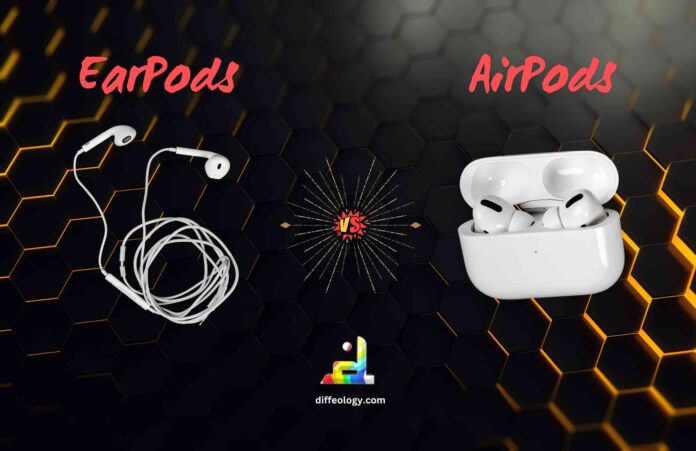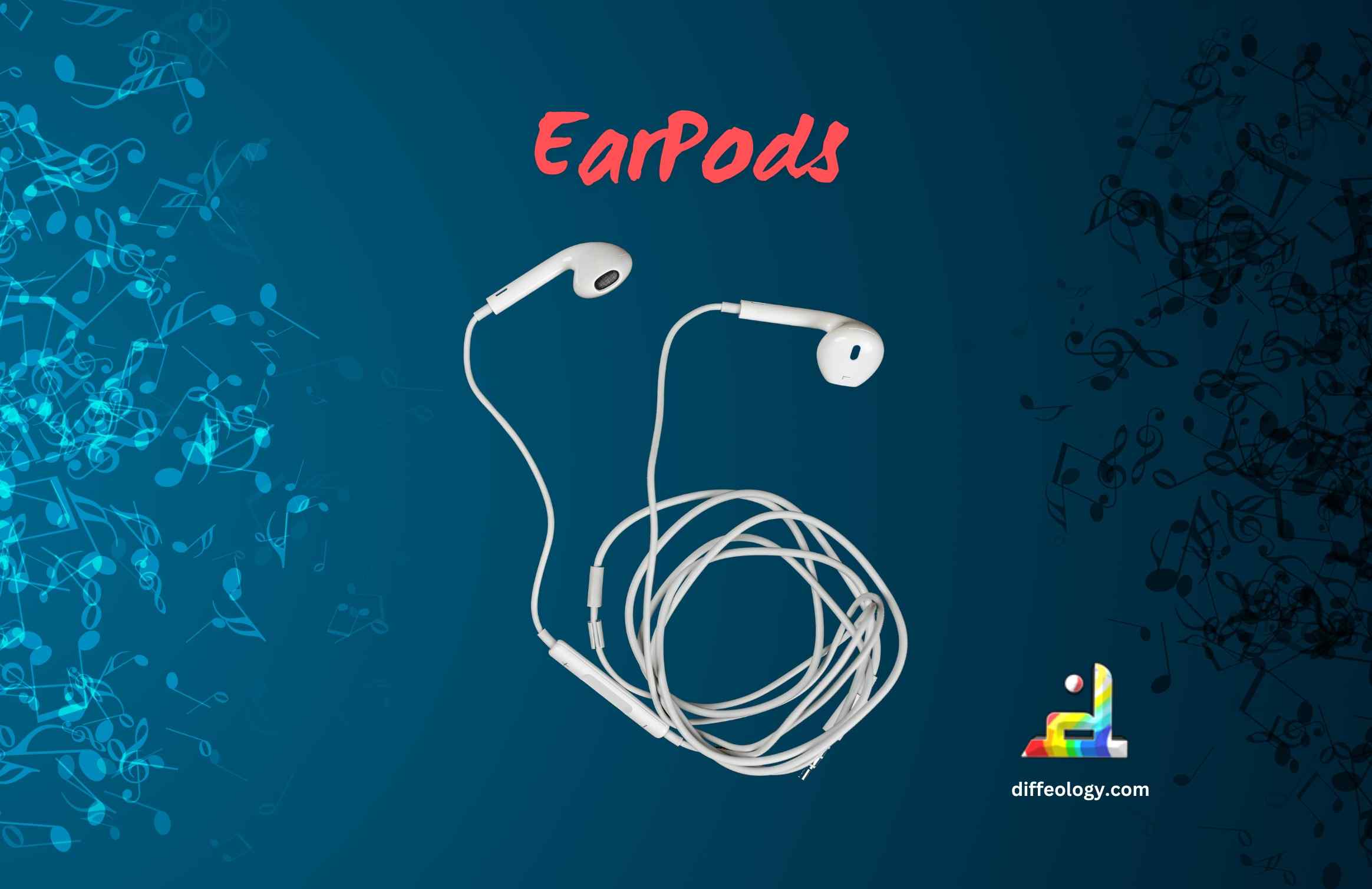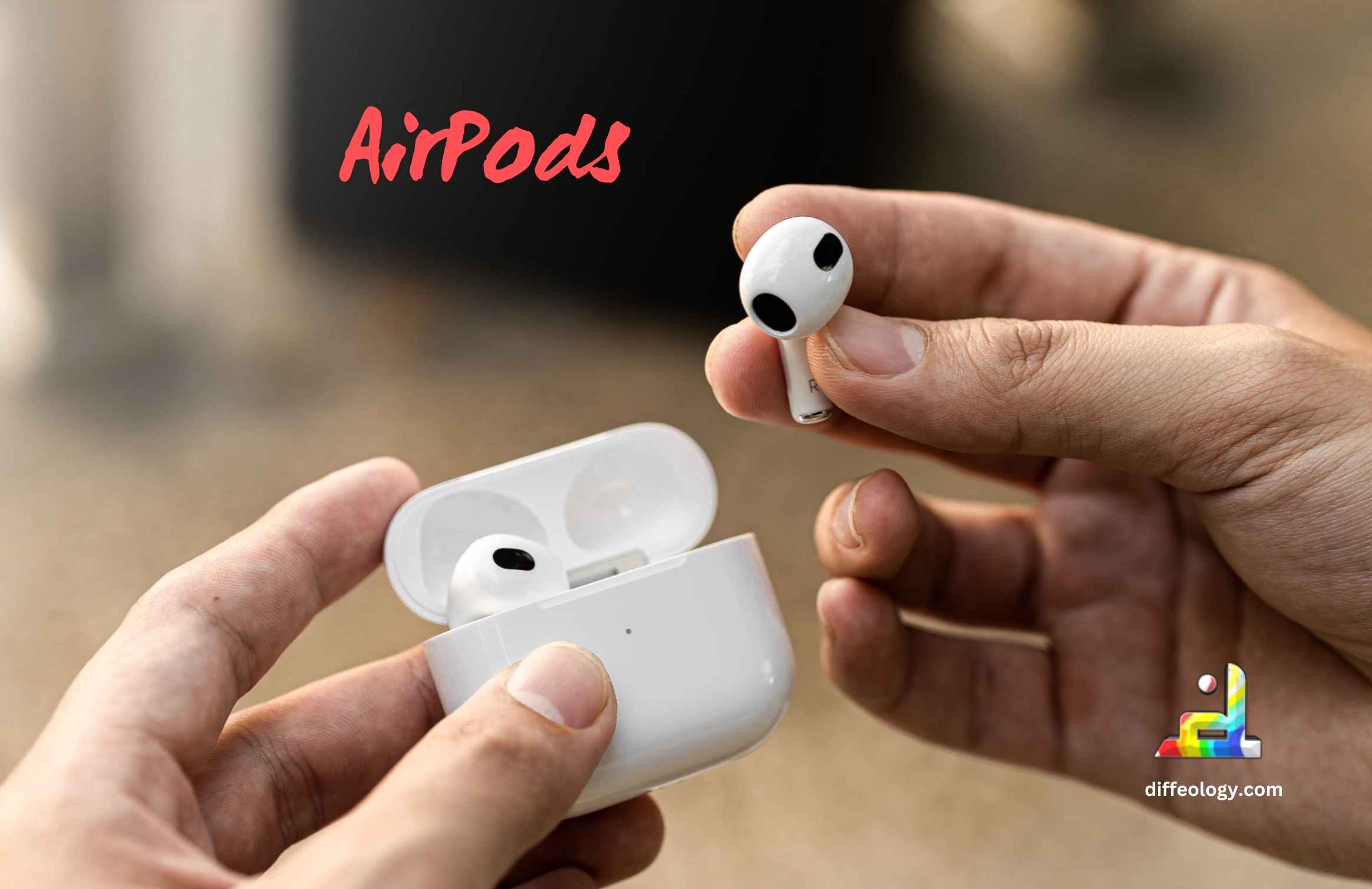EarPods and AirPods are both products of Apple designed for audio consumption. There is a huge Difference Between EarPods and AirPods in terms of technology and functionality. EarPods are traditional wired earphones that connect via a headphone jack or Lightning port, whereas AirPods represent Apple’s wireless solution, connecting seamlessly via Bluetooth. Understanding the distinctions between these two can help consumers choose the option that best fits their needs, whether it’s for convenience, audio quality, or compatibility with Apple devices.
Main Difference Between EarPods and AirPods
EarPods do not have a built-in battery; they are powered directly by the device they are connected to. AirPods have a built-in battery and come with a charging case for wireless charging. EarPods do not have a built-in battery. AirPods typically offer around 5 hours of listening time on a single charge, with additional charges provided by the case. EarPods have basic controls (play/pause, volume adjustment) located on the cable. AirPods have touch-sensitive controls on each earbud for managing playback, calls, and activating Siri.
EarPods Vs. AirPods
What are EarPods?
EarPods are a type of earphones created by Apple. They are known for their distinctive design with small, round earbuds that fit into the ears comfortably. Unlike traditional earphones that often come with a cable connecting them, EarPods have a wired version that connects directly to devices through a Lightning connector or headphone jack. This makes them compatible with a wide range of devices beyond just Apple products.
Read Also: Difference Between iPhone 15 and 15 Pro
One of the key features of EarPods is their universal fit, which means they are designed to be comfortable for most people, though this fit may vary from person to person. They offer decent sound quality suitable for everyday listening, making them popular accessories often included with purchases of iPhones. EarPods also feature basic controls like play, pause, and volume adjustment located on the connecting cable. They provide a convenient access to music playback without needing to interact directly with the device. Overall, EarPods are a simple yet effective choice for those looking for reliable earphones with a familiar design and ease of use.
What are AirPods?
AirPods are wireless earbuds created by Apple, designed to work seamlessly with their various devices like iPhones, iPads, and Macs. They come in a compact charging case that also acts as a portable battery. AirPods are known for their sleek design and ease of use. It makes them popular among users who prefer wireless audio solutions. They connect to devices via Bluetooth technology. So, they allow users to listen to music, make phone calls, or interact with virtual assistants like Siri without the hassle of wires.
Read Also: Difference Between Wifi and Hotspot
The latest AirPods models often include features like noise cancellation to block out background sounds for a clearer audio experience. They are also equipped with touch controls on the earbuds themselves. It enables users to adjust volume, skip tracks, or answer calls with a simple tap. AirPods have become synonymous with the trend towards wireless technology in personal audio, offering convenience and quality in a compact package.
Comparison Table “EarPods Vs. AirPods”
| Design | Wired earphones with a cable | Wireless earbuds without a cable |
| Connection | Connects via headphone jack or Lightning connector | Connects wirelessly via Bluetooth |
| Compatibility | Works with devices that have a headphone jack or Lightning port | Designed specifically for Apple devices (iPhone, iPad, Mac) |
| Controls | Physical buttons on the wire | Touch controls on the earbuds |
| Battery | No battery (powered by the device) | Has a built-in rechargeable battery |
| Charging | N/A | Charges in a case that doubles as a charger |
| Sound Quality | Standard audio quality | Enhanced audio with options for noise cancellation |
| Price Range | Generally cheaper | More expensive due to wireless technology |
| Noise Cancellation | N/A | Available in some models like AirPods Pro |
| Microphones | Single microphone | Multiple microphones for better voice clarity |
| Accessories | None | Includes a charging case and additional ear tips |
| Earpiece Design | Traditional earphone design | Ergonomic design to fit in the ear securely |
| Portability | Less portable due to wires | Highly portable and easy to carry |
| Voice Assistant | Depends on device support | Supports Siri and other voice assistants |
| Updates | No software updates | Receives firmware updates for new features |
| Water Resistance | Not water-resistant | Varies by model; some are water-resistant |
Difference Between EarPods and AirPods in Detail
1. Design and Comfort:
EarPods are the wired earphones that come bundled with iPhones. They have a traditional earbud design with a cable connecting them to your device. The shape is designed to fit comfortably in most ears, but since they have wires, they can sometimes tangle or get caught on things.
AirPods, on the other hand, are wireless earphones. They have a more modern, sleek design with no wires connecting them to your device. AirPods are known for their convenience and comfort, as they sit in your ears without any cords. They are designed to be lightweight and fit securely, making them easy to wear for long periods.
2. Connectivity:
EarPods connect to your device through a wired Lightning connector or a traditional headphone jack (depending on the model). This means you need to physically plug them into your device to use them. They work with a wide range of devices beyond just iPhones, including iPads, iPods, and some computers.
AirPods, on the other hand, connect wirelessly via Bluetooth. They are specifically designed to work seamlessly with Apple devices, such as iPhones, iPads, Macs, and even Apple Watches. Once paired with your device, AirPods automatically connect whenever you take them out of their case, providing a hassle-free experience.
3. Charging and Battery Life:
EarPods do not have a built-in battery as they are wired. They draw power directly from the device they are plugged into. This means they do not need to be charged separately but rely on the battery of your device.
AirPods, being wireless, come with a built-in battery. They are housed in a charging case that not only protects them but also charges them when they are stored inside. The AirPods themselves have a limited battery life, typically around 5 hours of listening time, but the charging case can provide multiple full charges, extending their use significantly.
4. Controls and Features:
EarPods have basic controls like play/pause and volume adjustment built into the cable. Depending on the model, they may also include a microphone for making calls and controlling voice assistants like Siri.
AirPods have touch-sensitive controls on each earbud that allow you to play/pause music, skip tracks, answer calls, and activate Siri with a tap or voice command. They also feature automatic ear detection, which pauses playback when you remove one or both AirPods from your ears.
5. Sound Quality:
EarPods provide decent sound quality suitable for everyday listening. They offer balanced audio with good clarity and enough bass to enjoy music and videos comfortably.
AirPods are known for delivering better sound quality compared to EarPods. They offer richer bass and clearer highs, providing a more immersive listening experience. The wireless connection also helps reduce interference and improve audio quality.
6. Compatibility and Integration:
EarPods are compatible with a wide range of devices beyond just Apple products. They can be used with any device that has a standard headphone jack or Lightning connector, making them versatile for various audio needs.
AirPods are specifically designed to work seamlessly with Apple devices due to their integration with the Apple ecosystem. They offer features like automatic device switching and iCloud syncing, allowing you to easily switch between devices and access your settings across all your Apple products.
7. Price and Value:
EarPods are typically more affordable than AirPods. They often come bundled with iPhones or sold separately at a relatively low cost compared to wireless earphones.
AirPods are more expensive due to their wireless technology, premium design, and additional features. They are considered a higher-end option for those looking for convenience, advanced functionality, and seamless integration with Apple devices.
Key Points Showing the Difference Between EarPods and AirPods
- Design and Form Factor: EarPods are wired earphones with a traditional earbud design and a cable. AirPods are completely wireless earphones with a sleek, minimalistic design.
- Connectivity: EarPods can connect to devices via a Lightning connector or headphone jack. AirPods can connect wirelessly to devices using Bluetooth technology.
- Automatic Ear Detection: EarPods are wired connections, and there is no automatic detection feature. AirPods automatically pause when taken out of the ears and resume when put back in.
- Compatibility: EarPods are compatible with a wide range of devices beyond just Apple products. AirPods are specifically designed to work seamlessly with Apple devices like iPhones, iPads, and Macs.
- Sound Quality: EarPods offer decent sound quality suitable for everyday use. AirPods provide improved sound quality with enhanced bass and clearer highs.
- Price Range: EarPods are generally more affordable and often included with iPhone purchases. AirPods are higher priced due to wireless technology and premium features.
- Physical Controls: EarPods have physical buttons for controlling music playback and volume adjustment. AirPods have a touch-sensitive surface for gesture-based controls.
- Design Comfort and Fit: EarPods are designed for a universal fit, which may not be ideal for everyone. AirPods are ergonomically designed to fit comfortably in the ears and stay securely.
- Weight and Portability: EarPods are lightweight but limited by the cable’s tangling potential. AirPods are ultra-lightweight and compact, offering easy portability without cables.
- Siri Integration: EarPods have limited interaction with Siri via the connected device. AirPods offer quick access to Siri using voice commands directly through the earbuds.
- Noise Cancellation: EarPods do not offer active noise cancellation. AirPods: Some models offer active noise cancellation for an immersive sound experience.
- Water and Sweat Resistance: EarPods are typically not water or sweat-resistant. AirPods: Some models are water and sweat-resistant, suitable for active lifestyles.
FAQs: EarPods Vs. AirPods
Conclusion:
Knowing the Difference Between EarPods and AirPods is simple. While EarPods offer simplicity and affordability with their wired design, AirPods provide the convenience of wireless connectivity along with advanced features like touch controls, noise cancellation, and a rechargeable case. Each has its strengths depending on the user’s preferences, making them suitable for different lifestyles and audio preferences in today’s tech-driven world.



